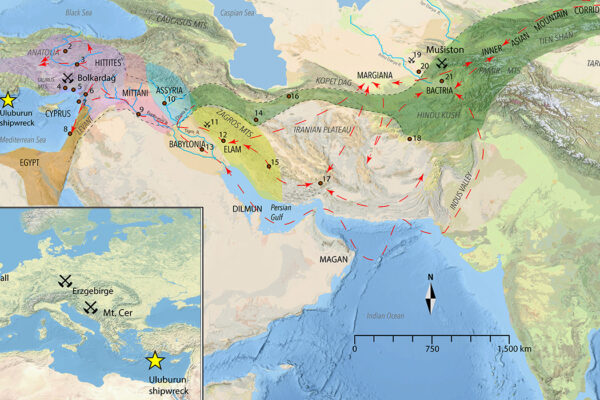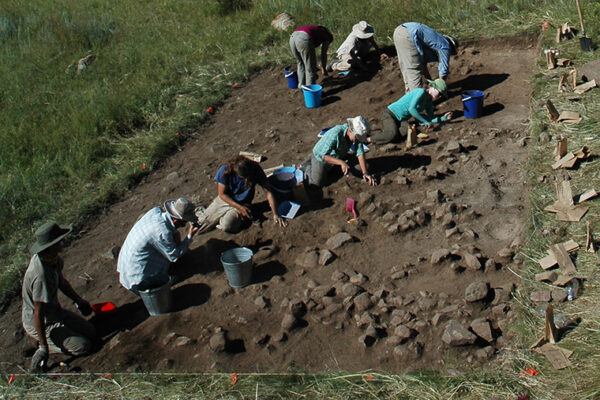Spurred by the current climate crisis, there has been a heightened attention within the scientific community in recent years to how past climate variation contributed to historic human migration and other behaviors.
Now, an international group of scientists — including archaeologists, historians, climate scientists, paleo-scientists, a volcanologist and others — are calling for a strengthened commitment to transdisciplinary collaboration to study past and present human-environmental interactions, which they say will advance our understanding of these complex, entangled histories. Their recommendations were published Nov. 22 in Science Advances.
In doing so, the group has introduced a new tool, the “dahliagram,” to enable researchers to analyze and visualize a wide array of quantitative and qualitative knowledge from diverse disciplinary sources and epistemological backgrounds.
“Backed by higher-resolution data concerning past climates, environmental change is increasingly seen as a crucial factor in debates concerning social, political and economic change — and human behavior generally — through time and space,” said Michael Frachetti, a professor of archaeology in Arts & Sciences at Washington University in St. Louis, and a lead author of the paper.
“Yet interdisciplinary attempts to cross data from history, climate science, archaeology and ecology to model past social-environmental interactions are challenged by mismatched units of measure and degrees of uncertainty.”
The dahliagram attempts to overcome those challenges by creating a universal and visual language to enable cross-disciplinary collaboration. Moreover, it allows researchers to compress vast amounts of data into a single, easy-to-interpret model.
Named for the dahlia flower whose petals bloom in concentric arrays, the dahliagram’s “petals” illustrate the relative impact of different pull and push factors contributing to human behavior over time. For example, the petals could represent the climate and environment, conflicts, politics and power, technology and resource availability. These are just examples, though. One of the benefits of the tool is that it is fully customizable to meet each study’s needs.
According to Frachetti, the tool is meant to stimulate conceptual thinking and promote critical engagement, dialogue and debate. It welcomes data from domains of research like history or archaeology that are not easily quantified as factors in understanding behaviors like migration. And it requires the user to think beyond simply causality and consider the unique intersection of social, economic, political and environmental conditions for each case.
“The tool not only allows for a more nuanced understanding of complex data, but also can be a ‘gut check’ — a way of testing your hypotheses and assumptions,” Frachetti said.
Testing the dahliagram
To test the capabilities of the proposed dahliagram tool, the group created three models that assess the impacts of a range of factors on local- to large-scale mobility in three pivotal regions of world history: eastern Africa, inner Eurasia and the North Atlantic. These selected case studies range in chronological scale from decades to centuries to millennia.
Although the dahliagram is a universal device for human-environmental research, for the purpose of this study, the researchers focused on human mobility as a behavioral response.
In each model, “movement” is placed at the center of the dahliagram while different factors are represented in a surrounding array of petals. The team synthesized volumes of research and data on each factor and then ranked it according to its influence from low to high over three concentric rings of increasing intensity.
“One of the challenges to studying past phases of migration is that there’s very rarely a single driver. It’s usually a multitude of things that are impacting the people. Changes in the climate or access to resources could be one factor, but it’s usually accompanied by something like war, new innovations, economic or political pressures, etc. The people in the Sahara, for example, have adapted to desertification for more than 5,000 years, making a simple driver for their patterned mobility, or a discrete migratory event, rather unlikely,” Frachetti said.
An interesting thing happened when the team compared the dahliagram models for each of the three case studies. Although they are separated historically by hundreds of years and thousands of kilometers, unexpected parallels between the cases became obvious to the team.



“Population movement within emergent empires in both Asia and East Africa appears to be rooted in similar forces of political and social identity, as well as ambitious interests to acquire regional resources and stimulate trade and connectivity,” the authors write. “Environmental factors were an omnipresent concern but appear to be outweighed by factors such as conflict and sovereignty.
“The historical implications of mobility within these formative empires in their respective era and region are unique, but only when visualized in the dahliagram do we see the shared correlations across an array of factors that may produce fruitful onward investigation into their behavioral similarities at the human-environmental nexus.”
Overall, the group found the dahliagram to be effective in assessing population movements that occurred within richly documented historical time scales, as well as over long periods of time.
“We now hope that our new dahligram approach will be applied by many scholars from different fields across the natural and social sciences and the humanities to enhance interdisciplinary investigations into the entanglements between nature and humans,” said Ulf Büntgen, a professor of environmental systems analysis in the Department of Geography at University of Cambridge, U.K., and a lead author of the paper.
Inspired by and built for transdisciplinary research

In recent years, the academic community has embraced the concept of transdisciplinary research. Like interdisciplinary or multidisciplinary research, transdisciplinary research connects scholarship from various disciplines to more fully grasp the complexity of problems and enable creative problem solving and discovery. What makes transdisciplinary research unique is that it incorporates the perspectives of non-academic stakeholders, including members of tribes and ethnic groups, historians, artists and other subject-matter experts.
Translating and effectively communicating complicated findings and uncertainties across disciplines, and with non-academic stakeholders, is not without its challenges, though. In fact, the idea for the dahliagram was inspired by the group’s ongoing transdisciplinary work in the “Volcanoes, Climate and History” project, which was convened by Ulf Büntgen and Clive Oppenheimer from the University of Cambridge and supported by The Center for Interdisciplinary Research (ZiF: Zentrum für interdisziplinäre Forschung) at Bielefeld University in Germany.
The dahliagram not only enables researchers to synthesize data from various sources with different metrics, it also helps ensure equity among the various contributors, Frachetti said. Moreover, the visual nature of the dahliagram is especially helpful when communicating with various stakeholders.
“This tool allows us to gather communities of specialists and fairly and collectively express our knowledge in a way that that is on equal footing, rather than allowing one discipline to lead the way. I think that that kind of equity is a significant component of what the dahliagram provides,” he said.
Ultimately, the team hopes the dahliagram will be adopted within the scientific community to stimulate further explorations of complex human behaviors by leveraging multidisciplinary team building and consensus.
The addition of the dahliagram will expand the analytical tools available for historical research, according to Nicola Di Cosmo, the Luce Foundation Professor in East Asian Studies at the Institute for Advanced Study in Princeton, NJ, and co-author of the study.
“Historians may be encouraged to use the dahliagram to translate into a visual representation a wealth of data from multiple sources and different disciplines and thus avoid monocausal explanations derived from limited datasets,” he said.
As for scientists, Frachetti said that some might initially have hesitations about the tool because it does not provide hard facts, but he hopes the community will come to appreciate the tool for what it does provide: a visualization of the facts.
“The dahliagram is a contextual tool that’s meant to help you question your assumptions and consider other explanations. And that’s really important because even our best ‘hard facts’ — things like tree rings and our measurements to monitor the planet’s health — are conditioned by assumptions and uncertainty.”
In addition to Frachetti and Büntgen, the following experts contributed to this paper: Nicola Di Cosmo, Institute for Advanced Study; Jan Esper, Johannes Gutenberg University; Lamya Khalidi, Université Côte d’Azur CNRS, CEPAM; Franz Mauelshagen, University of Bielefeld; Clive Oppenheimer, University of Cambridge; and Eleonora Rohland, University of Bielefeld.



